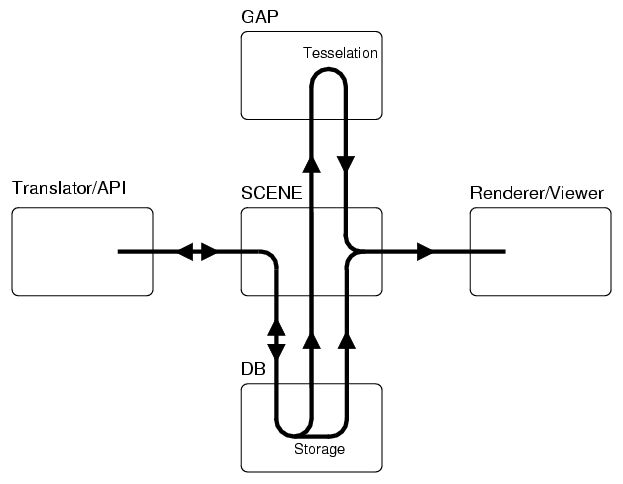
Scene geometry data flow
The Scene module provides a layer on top of the DB module. Its main purpose is to manage storage of the scene in memory, and to provide functions for global operations on the scene. It is used by all modules that deal with scene data, specifically for the API module. Scene also provides functions to convert the stored scene to a renderable representation that is accepted by other modules such as renderers, walkthrough viewers, or wireframe display functions, and uses the GAP module (the tessellator) for this purpose. In a dataflow sense, the Scene module sits in the pipeline between the translators and the renderer/viewer.
From Scene's point of view, a wireframe or hardware-shaded viewer is just another kind of renderer; the term ``renderer'' is used synonymously with ``viewer'' throughout the Scene documentation. The Scene module accommodates a wide range of different renderers; the render options data type provides fields sufficient for sophisticated ray tracers as well as simple hardware shading renderers. The Scene modules makes no assumptions about rendering-related data other than providing reasonable defaults; the actual interpretation of the data, and which parts of the data are used, depends on the renderer.

The bidirectional arrow from the translator to the DB module represents creating, editing, and deleting operations on the scene database. Some translators such as the .mi translator use the high-level API module to simplify scene creation. The Scene module manages this flow of data to keep track of changes. All other arrows represent the preprocessing stage managed by Scene that converts the source geometry created by the translator to a renderable representation accepted by the renderer. Note that the renderer may also access non-geometry data such as materials directly in DB without involving the Scene module; this diagram only shows geometry dataflow. There is also a postprocessing stage for cleanup after rendering completes.
Specifically, the Scene module has three main functions:
The term instancing indicates that
geometric objects
and lights can be stored once, but appear multiple times in the
rendered scene. This is implemented by storing the scene as a
hierarchy of instances that refer subtrees, geometry, or lights.
If multiple instances refer the same element, directly or
indirectly, that element is said to be instanced multiple times.
When traversing the hierarchy, the Scene module supports
programmable inheritance of shader parameters
such that higher levels of the hierarchy can pass shading parameters down
to lower levels. The exact method of inheriting information is
programmable, using an inheritance function
that combines the parent
parameter block and the child
parameter. The parameters being inherited this way follow the same rules
as standard shader parameters. Shaders have access to both their
standard static parameters, and to the inherited parameters.
mental ray supports traversal functions that replace older inheritance functions. Both are basically equivalent, except that traversal functions have access to the entire instance being inherited, and also receive a traversal graph history list from the root group down to the current instance. This gives the function more control, for example over material inheritance. The inh_is_traversal flag in the options block controls whether the function is an inheritance function or a traversal function.
Copyright © 1986, 2015 NVIDIA ARC GmbH. All rights reserved.